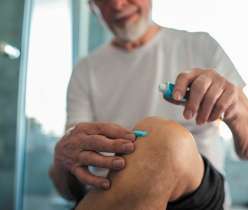Muscle pain is a challenging condition for both patients and healthcare professionals. Many adults have experienced one or more episodes of muscle pain at some time, regardless of age or gender. The problem affects around 47 percent of the general population. Inadequately managed muscle pain can adversely affect quality of life. Over one-quarter of Americans suffer from chronic pain. The failure to manage chronic muscle pain, as well as the opioid dependence related to chronic pain, can lead to significant morbidity and mortality.
Back muscle pain may be accompanied by tenderness, stiffness, and weakness of the affected muscles. Uncontrolled muscle pains, where you are normally aware of what brought them on, are usually easily treated at home with simple measures.
Self-care for muscle pain
Muscular pains, strains, sprains, and other soft tissue damage are best treated with a further regimen for 48 to 72 hours.
-
- Rest and avoid exercise for 48 to 72 hours.
- Apply ice or a cold pack for 10 to 20 minutes every 2 to 3 hours.
- Use a firm elastic pressure bandage to help limit the swelling.
- Keeping the injured body part raised helps reduce swelling.
Make sure you do not put ice directly onto the skin. You can use a commercial ice pack, following the manufacturer’s instructions, or wrap ice in a towel. After 72 hours, the damaged tissues generally begin to heal, and heat and massage may be introduced. It is always best to check with a physiotherapist before initiating heat treatments and physical activity to avoid the risk of further damage. To prevent leg cramps at night, stretch your calf and hamstring muscles before bed.
Treatment options for muscle pain
There are a variety of treatment options available to minimize muscle pain, including anti-inflammatory drugs, heat rubs, and painkillers. These are appropriate back strain treatments and help to lower back muscle pain.
Pain reliever medicines
Simple pain reliever drugs like paracetamol can be taken to minimize back spasms. Anti-inflammatory medications such as ibuprofen and aspirin can cause a significant reduction in pain and help minimize the inflammation that gives rise to pain. However, taking oral non-steroidal anti-inflammatory medications should be avoided in individuals dealing with aspirin sensitivity, stomach ulcers, or signs of indigestion. It should be taken carefully by people with asthma, dehydration, and kidney disease.
Topical Anti-inflammatory drugs
Topical anti-inflammatory medications for back strain treatment, like piroxicam, diclofenac, salicylates, and ibuprofen, effectively treat the body’s inflammatory reaction to injury, encouraging fast healing and reducing pain. Adverse effects of the medicine include rash and skin irritation. Rarely do people using these topical anti-inflammatory gels experience the same side effects as they experienced by their oral counterparts, such as heartburn.
Heat rubs
Lower back pain relief products such as heat rubs may relieve muscle stiffness, pains, or soreness. These promote the opening of blood vessels in the treated area and create a sense of warmth. Ensure you do not apply the heat rub to broken skin or near the eyes or mucous membranes, and it should not be used with sealed dressings. Be sure to wash your hands after applying the lotions, ointments, creams, or rubs.
Acupuncture
This muscle spasm treatment option helps treat muscle aches and pains. It involves using long, thin needles to allow stimulation of nerves in the muscle. This contributes to the production of endorphins, which help to relieve some symptoms. The therapy is also effective in neck strain treatment that helps alleviate a wide range of symptoms, commonly including muscle pains and extreme stiffness.
You should seek medical advice in case any of the following applies to you:
-
- You have a serious muscle loss movement
- The back spasms are severe
- The pain begins after taking a new medicine
- The muscle pain is accompanied by fever
- You have dark-colored urine
- The pain is due to a back or neck injury
- The pain is associated with weakness
If you have severe muscle spasms in lower back treatment is necessary. To avoid or minimize sore muscles and muscle cramps, begin slowly when starting a new exercise program or activity and gradually increase the intensity and duration of the activity, but only increase one at once.
Warming up before indulging in an intense workout can help prevent muscle strains and sprains but generally won’t help you avoid muscle aches.




